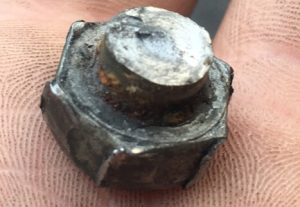This week, I have been entertained on my drive to work by a BBC Sounds podcast called Glued Up: The Sticky Story of Humanity. Mark Miodownik, a materials scientist, engineer, broadcaster and writer at University College London, narrates five 15 minute episodes charting the journey of human progress through the sticky substances that have shaped us.
The first episode begins:
Early in Spring 2023, a story in the news caught my attention. “Inspectors found a defect on a nuclear submarine it has emerged. HMS Vanguard was found to have a defect from work done in the past, the Ministry of Defense has said.” Apparently the defect was that the workers had used superglue to carry out repairs on the reactor chamber. Some bolts on the cooling pipes have been over tightened, the heads are snapped off, and instead of replacing the bolts, someone had glued the heads back on again. Now you might think that’s just one of those funny stories about state level bungling. But what I find so interesting is that at first glance, using superglue to hold together something as complex and important as a nuclear sub is a terrible idea. Look a bit closer, however, and you’ll see that nearly all of our high tech modern world is held together by glue, from phones to wind turbines, from cars to planes, from our shoes, to the fillings in our teeth. Our society would literally fall apart without adhesives. In fact, it’s no exaggeration to say that glues underpin many of our greatest technological leaps forward as a species. It turns out that the story of humanity is surprisingly sticky.
 Good grief! Someone had glued the heads back on again… I agree, using superglue as a short cut and a cover up like this is a terrible idea. Nevertheless, there may be perfectly valid uses for superglue (or as we prefer to say, cyanoacrylate adhesive) on a nuclear submarine as long as the substrates, bondline design, forces and stresses, and environmental concerns have been evaluated.
Good grief! Someone had glued the heads back on again… I agree, using superglue as a short cut and a cover up like this is a terrible idea. Nevertheless, there may be perfectly valid uses for superglue (or as we prefer to say, cyanoacrylate adhesive) on a nuclear submarine as long as the substrates, bondline design, forces and stresses, and environmental concerns have been evaluated.
This is a light hearted series, aimed at the mass market rather than the engineering professional. The last episode deals with “reversible” adhesives and how they may be key to a sustainable future; there is merit in the idea, but I think we are not commercially there yet. I won’t necessarily recommend the series to our customers. But if you have read this and have an adhesives application on your nuclear submarine, let’s get started by talking about your application.
Posted by Peter Swanson
Peter is the Founder and Executive Chair of Intertronics. He is mostly involved in strategy, recruitment and helping out the Marketing team.
Who's Peter?Categories: adhesives, cyanoacrylate adhesives, insights, sustainability
